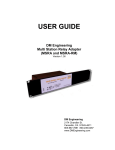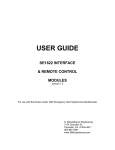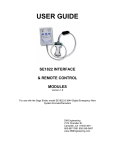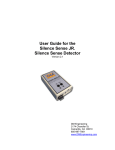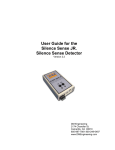Download docs/MSRA User Manual v1_35
Transcript
USER GUIDE DM Engineering Multi Station Relay Adapter (MSRA and MSRA-RM) Version 1.35 DM Engineering 2174 Chandler St. Camarillo, CA 91345-4611 805-987-7881 800-249-0487 www.DMEngineering.com Overview: The DM Engineering Multi Station Relay Adapter (MSRA) is a microprocessor based, three stereo channel accessory for the Sage-Endec EAS encoder-decoder, models SE1822 and the 3644 Digital when used in the analog audio configuration, that expands the allowable controlled number of stations to a total of four from a single Sage-Endec EAS Encoder-Decoder. The MSRA is available in both a table top version and a 2U rack mount version (MSRA-RM). The Endec has embedded programming that allows additional stereo or mono stations, in addition to the station controlled within the Endec itself, to be controlled using Multi Station Relay devices such as the DM Engineering MSRA. All digital commands and EAS audio are supplied by the Endec, and the MSRA interprets these commands to select the appropriate station or stations for EAS broadcast. Digital control communications between the Endec and the MSRA is accomplished via RS232 at 1200 baud through either the COM 4 or COM 5 (1200 baud) ports on the Model SE1822, and on any port on the 3644 Digital when programmed to do so. (See Endec Programming procedure below) EAS audio for the MSRA is derived from the “Speaker Line Output” (SE-1822) or “Line Out” (3644 Digital) connection on the rear of the Endec. A multi-turn recessed front panel “ Input Gain” trim potentiometer and individual multi-turn “Station Gain” controls on the MSRA are provided for controlling the active stereo distribution amplifier sections having balanced output levels capable of greater than +12dBm into a 600 ohm load impedance. A recessed front panel “Test” switch is also provided for aiding the setup of the audio levels. (See Audio Setup procedure below) An optically isolated open emitter and collector “Tally” output is provided for user interface and is active when any or all of the 3 MSRA controlled stations are activated, and remains active until the end of the EAS activation. The MSRA is transparent to program audio due to it’s loop-through design, and uses 6 high quality bifurcated gold over silver nickel contact sealed relays, one relay for each left and each right channel circuit. The MSRA also is designed to remain transparent to program audio during a power failure condition. All station inputs and outputs are connected using large 5mm Eurostyle screw type pluggable connectors for wiring ease and connection reliability. The internal power supplies, precision regulators, precision audio distribution amplifier sections and quality components throughout assure long life and trouble free operation of the MSRA. No external power supplies (wall warts) are required. Front panel LED indicators are provided for “Power” and “Station” left and right audio relay activation during an EAS event. The MSRA is internally protected by a 1/4A AGC type fast blow fuse. 2 Installation: 1. The MSRA should be located in an area that is not subjected to temperatures in excess of 85 degrees centigrade, nor subjected to moisture greater than 90% relative humidity, non-condensing. 2. Station audio connections are made using the pluggable Eurostyle connectors. Wires should be stripped approximately ¼ inch and fully inserted into the connector. Assure that the connector locking screws are fully tightened and that the wires are secure. The MSRA insertion in the station audio chain should be made between the stations main audio source and the input to the stations processing equipment. Balanced input and output (+ and -) connections are made for each applicable station audio chain for both the left and right channels as indicated on the MSRA. It is important that at no time should any of the + or – outputs be connected to ground. Grounding any of the active outputs for an extended period of time may cause damage to the individual amplifier IC and will not be covered under the MSRA warranty. 3. RF protection is incorporated within the MSRA, but in some high RF environments it may be advisable to connect a lead from any of the MSRA station “Ground’ terminals to your station ground. 4. Data and audio connections are made using the supplied Data/Audio Modular to DB9 cable. The DB9 female connector is connected to either the Endec COM4 or COM5 port (SE-1822) or any properly programmed COM port on the 3466 Digital. (See Endec Programming section below) The audio connection is made by connecting the red wire to the Endec “Speaker Line” (SE-1822) or “Line Out” connection (3644 Digital) and the black wire to any of the Endec “Audio Common” or “Gnd” connections. Audio levels are set according to the “Audio Set-up” section below. The RJ11 modular connector is connected to the MSRA Data/Audio input port. For long distance runs between the MSRA and the Endec, the use of CAT5e cable is recommended for the extended run. Both audio and data may be sent using CAT5e cable except in high RF environments where a separate shielded pair should be used for the audio. (See drawing below for the Interface Cable Schematic) Optional CAT5e cable extensions up to 500 ft. are available from DM Engineering at an additional cost. 3 MSRA Interface Cable Schematic 5. The “Tally” output is not required to be used for proper operation of the MSRA. It consists of an optically coupled open collector/emitter NPN transistor for external signaling that is active when any or all of the MSRA relays are activated. The transistor can dissipate 150mw at 30 volts maximum, emitter to collector. The collector connection is designated by a “+” symbol, the emitter by a “–“ symbol. 6. The MSRA is connected to the 120VAC mains via the 2 prong 6 foot AC cord. Set-up and Operation A. Endec Programming Reference section 9.2(SE1822) or section 10.2 (3644) of the Sage-Endec User Guide and Reference Manual for complete details. Entry of a password will be required to complete most of the steps below. Do not reassign any of the MSRA relays to stations using the msrp.assign msrp relay menu unless you are positively sure of what you are doing. The default settings are the proper settings for most installations. 1. Assign either COM4 or COM5 (1200 baud ports on the SE 1822), or any port on the 3644 Digital to be used as a RELAY device for using the MSRA. (menu.devices.COM”X”.device type.relay) X=selected COM port. 2. For the 3644 Digital it will be necessary to set the baud rate to 1200 baud for the COM port chosen by using: (menu.devices.COM”X”.baud rate) X=selected COM port. 3. Set up the call sign for each station by using: (menu.MSRP.station #. call sign). The # character is the station number 2-4. Follow the prompts to install the desired station call signs for stations 2-4. 4. Enable each station desired by setting: (menu.MSRP.station #.enable) to “YES” for each desired station. 5. The 3644 Digital Endec is shipped with the digital audio enabled by default. It will be necessary to disable the digital audio. This may be done from the Endec front panel by setting: (menu.digital audio) and select “NO” at the prompt to disable digital audio, or by selecting the software program Endecsetd digital audio tab and disabling the digital audio. You may be asked to re-boot the Endec and you will need to recycle the Endec power for the changes to take effect. See section 4.5.4 of your 3644 manual for details. 4 B. Other COM Port Devices (if used) 1. If Remote Controls such as the DM Engineering Ultimate, Ultimate Jr., SE1822 Remote Control and Automation Interface, any other DM Engineering Automation Interface module or the Sage RC-1 are to be used, configure the appropriate ports for the “Hand Control” option by selecting: (menu.device.COM”X”.type.hand control) X=selected COM port. Note that DM Engineering Remote Controls and Automation Interface Modules are 9600 baud devices and may be used to control COM ports1 on the front panel (variable baud rate), 2 (fixed 9600), 3 (variable) and 6 (fixed 9600). COM1 and 3 may be set to the desired baud rate by selecting (menu.device.COM”X”.baud rate) X=selected COM port. The RC-1 Remote Control is a 1200 baud device and must be configured for either COM1, 3, 4 or 5, whichever is not being used for the MSRA and/or other Remote Controls or Automation Interface modules. 2. The last command to assign the Remote Control or Automation Interface Module to its specific station is: (menu.devices.COM”X”.station) X=selected COM port. C. Audio Set-up 1. The MSRA EAS audio output is factory set at unity gain to deliver a -10dBm output into 600 ohms with the Endec default Attention and/or Data Tone gain levels set at the default value of 32 (-10dBm). The MSRA factory settings may be required to be readjusted after initial set-up of the Endec. The user should set the Endec EAS “Attention Tone” and “Data Tone” modulation levels to achieve a minimum of 80% modulation on all stations and the Attention and Data tones should be balanced to within 1 dB, left and right channels, to be in compliance with Part 11 of the FCC Rules. The MSRA relies on these tones to be balanced as the precision distribution amplifier sections will faithfully reflect this balance or imbalance. Refer to section 4.3 (SE1822) or 4.4 (3644) of the Endec User and Reference Guide for detailed instructions. 2. After initial audio set-up of the Endec as described above has been completed for Station 1, the XLR outputs on the Endec itself, and the proper modulation levels and balance have been achieved, the individual “Station Gain” controls may need to be adjusted on the MSRA to achieve a minimum of 80% modulation when an attention tone is transmitted. Each “Station Gain” control simultaneously adjusts both left and right levels of the balanced precision MSRA amplifiers as detailed below. 3. To generate an attention test tone for setting the audio levels in the MSRA enter (menu.levels.attn tone) You will be prompted to choose which relays are activated for audio set-up. Pressing and holding the recessed “Test” button on the MSRA will activate stations 2-4 relays simultaneously to aid in audio level set-up. Note: Do not arbitrarily change the levels on the Endec itself as they may have been previously been set for the correct levels for station 1. To end the test tones press done or abort. 5 4. If the Endec audio outputs have been significantly increased beyond the default values, (32), the MSRA output waveform of any one channel of any of the station outputs should be checked using an oscilloscope to assure that the input stage is not being overloaded. Overloading will be noted by observing any clipping of the MSRA output waveform. Adjustment of the “Input Gain” trimmer potentiometer may be required to avoid clipping. This control has limited effect on the input gain stage and is designed for only reducing an overloaded input condition or increasing all three MSRA outputs simultaneously if required. Set the appropriate “Station Gain” multi-turn potentiometers to get the desired modulation levels for each station. 5. Final testing of the system may be done by generating an RWT by entering (week. your password.STN). Follow the (yes-no) prompts to test any or all of the stations, 1-4 and then (proceed). Specifications: Loop-through Frequency Response: Loop-through Signal to Noise: Loop-through Channel Separation: EAS Audio Input: EAS Audio Output: Switching Relays (loop-through): Logic Control: Logic and audio I/O Interface: Status Indication: Power Requirement: Size: Optional Rack Mount: DC to 20 kHz, +/- .1dB >80dB >80 dB -10 to +10 dBm -10 to +12 dBm Sealed, with bifurcated gold clad over silver nickel contacts, 2 per stereo channel 8 bit PIC Microprocessor RJ11 modular to DB9 RS232 (Logic) and wire leads (audio) Front Panel LED Power and EAS Station Relay Active indicators 105-125VAC, 50-60Hz (internally fused at 1/4 A) 9 X 6X 2 3/8 inch ABS cabinet MSRA-RM (1 MSRA on one 2 unit high 19” panel), Warranty Information: The DM Engineering MSRA and is warranted for a period of one year from the date of purchase. This warranty covers materials and workmanship only. Any misapplication, physical or electrical damage from outside sources or by the customer is not covered. The customer must pay shipping costs to the factory, and DME will pay shipping costs to return the warranted equipment to the customer. Any priority shipping costs are to be the responsibility of the customer as ground service is standard. Please contact the factory for an RMA number prior to any returns. Items returned without an RMA may be sent back to the customer unopened. Technical Support If you have questions, experience difficulties with the product or require further information please contact DME at: 805-987-7881, toll free 800-249-0487, or E-mail technical support at: [email protected], or visit www.dmengineering.com for the latest User Guide. 6






